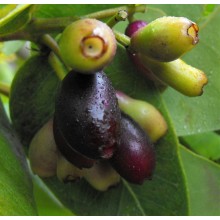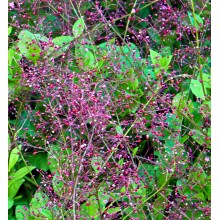Piante resistenti alla siccitá Ci sono 141 prodotti.

In questa sezione, raggruppiamo quelle piante che si adattano alle condizioni aride o di siccità. Normalmente, la maggior parte di queste specie, coltivate in condizioni di asciutto, sono cerosi, succulenti, pelosi, appiccicosi, aghiformi ed ancora più piccole rispetto al resto.
In Piante resistenti alla siccitá si possono trovare tutte le specie con queste caratteristiche: Pithecellobium dulce, Ruta graveolens, Syzygium cordatum, Tamarindus indica e così via.
-
Punica granatum 'Dente di cavallo'
Punica granatum 'Dente di cavallo'
Dente di Cavallo is a traditional Italian variety of cold-hardy pomegranate. Fruits ripen at the end of September. They are medium-large, with a green skin tinged with red. Inside it is ruby red, sweet and delicate in flavour. The seeds are hard, woody inside, reminiscent of horse teeth (that means "dente di cavallo") due to their trapezoidal shape.
56,20 € -
Punica granatum 'Mollar de Elche'
Punica granatum 'Mollar de Elche'
This is the most popular cultivar of pomegranate from Spain. Easy to grow, it quickly bears pink-red large good fruits of even size, with dark red arils and very small and soft seeds. They ripen between October and November. Pomegranates are vigorous small trees, resistant to moderate frost and heavy droughts. They can be kept as large shrubs of 2-3 m and...
44,70 € -
Punica granatum 'Parfianka'
Punica granatum 'Parfianka'
Parfianka is considered by many the most tasty or flavourful cultiva of this fruit. It belongs to the group of "Russian Pomgranates", which are known for being early-bearers and for their resistance to frost and heat.
56,20 € -
Punica granatum 'Wonderful'
Punica granatum 'Wonderful'
Wonderful is a self-fertile variety selected in the USA, and today it is one of the most cultivated in the the world. Fruits ripen at the end of October with an intense and uniform red colour, often glossy. They are large in size, with a rounded shape and elongated crown. Taste is sweet and acid and seeds are rather soft.
53,00 € -
Scilla sicula
Scilla sicula
The Sicilian Squill (Scilla sicula) is a bulbous herbaceous perennial (geophyte) with smooth elongate leaves pointed at the tip. It is distinguished by pale flowers and broad, marginally ciliate leaves (with a line of short, white hairs).
34,00 € -
Sedum hirsutum subsp. baeticum
Sedum hirsutum subsp. baeticum
Cute small Sedum native to Southern Spain and possibly NW Africa. It grows as small compact rosettes of green pubescent leaves, held on low stolons. It flowers from June to August with white star-shaped blossoms with wide petals.
10,30 € -
Sempervivum calcareus
Sempervivum calcareus
Native to Southern Eruope from about 200 to 2800 m, it has neat stolinferous rosettes with a red hue, and ciliate ("Hairy") leaf margins. It naturally grows in rocky outcrops and cliffs, but it became well known in ancient times since it was typically found on roofs, hence the name "tectorum", meaning "of the roofs"
10,70 € -
Sempervivum tectorum
Sempervivum tectorum
Native to Southern Eruope from about 200 to 2800 m, it has neat stolinferous rosettes with a red hue, and ciliate ("Hairy") leaf margins. It naturally grows in rocky outcrops and cliffs, but it became well known in ancient times since it was typically found on roofs, hence the name "tectorum", meaning "of the roofs"
10,70 € -
Strelitzia reginae 'Juncea' - Large
Strelitzia reginae 'Juncea' - Large
This strelizia is adapted to harsh conditions and lacks normal leaves. Leaf stalks taper to a tip with no blade, so the leaves look like fleshy spikes. The flower is much like the popular bird of paradise.
68,90 € -
Syzygium cordatum - LARGE - Water Berry
Syzygium cordatum - LARGE - Water Berry
Shrub to medium size tree from South Africa to Mozambique. It has a very dense foliage and edible purple-black sweet fruits, very rich in anti-oxidants. It stands harsh conditions and grows in Mediterranean to Tropical conditions.
77,30 € -
Syzygium cordatum - Water Berry
Syzygium cordatum - Water Berry
Shrub to medium size tree from South Africa to Mozambique. It has a very dense foliage and edible purple-black sweet fruits, very rich in anti-oxidants. It stands harsh conditions and grows in Mediterranean to Tropical conditions.
38,50 € -
Syzygium oleosum - Lilli Pilli
Syzygium oleosum - Lilli Pilli
Shrub or small tree with edible sweet, aromatic purple fruits. It is very easy to grow, hardy to drought, wind and moderate cold. It thrives outdoors on the Mediterranean coast and can be pruned as a hedge or kept as a small shrub.
30,00 € -
Talinum paniculatum
Talinum paniculatum
Tuberous-rooted perennial native to Tropical America, with fleshy leaves and delicate pink flowers followed by the small and colourful pink-white-yellow-red fruits. It is considered an ornamental, a caudiciform. a medicinal plant. and in some countries even used as a vegetable
11,50 € -
Tamarindus indica
Tamarindus indica
Tamarind is the famous sweet-and-sour fruit of ancient times. It is a semi-evergreen tropical tree native to East Africa but now spread in tropical Asia and South America. Pulp, leaves and bark have medicinal properties.
42,00 € 51,00 €Prezzi ridotti! -
Vasconcellea quercifolia - Oak Leaf Papaya
Vasconcellea quercifolia - Oak Leaf Papaya
Deciduous relative of domestic papayas. Fruits are 2-5 cm long, sweet and juicy, quite nice to eat. It is easy to grow in harsh, mediterranean conditions as it takes drought and some cold too. With age it will form a "fat" trunk.
34,60 € -
Welwitschia mirabilis
Welwitschia mirabilis
Welwitschia is a myth of botany, being one the most unusual plants in this world. It came from a very ancient plant lineage and survived to the modern era in the barren deserts of Angola and Namibia.
144,60 € -
Xerosicyos danguyi
Xerosicyos danguyi
This plant is popular and easy in cultivation. Stems and leaves are grey-silvery and each leaf resembles a coin. A few spiralling tendrils are produced here and there.
16,30 € -
Yucca gigantea 'Jewel'
Yucca gigantea 'Jewel'
Variegated selection of the popular Yucca. It can eventually become a tall tree-like yucca but it can also be used as an indoor plant.
24,50 € -
Zamioculcas zamiifolia
Zamioculcas zamiifolia
This aroid from semi-dry areas is named so because of the similarity with some cycads in the genus Zamia. It is native to E - SE Africa, that resists to many different conditions. Its showy glossy leaves are produced from a stout underground, succulent rhizome. It is very easy to grow, and the unusual flowers are a nice addition.It is normally evergreen,...
12,40 €
Al momento ci sono pochi prodotti in questa categoria Piante resistenti alla siccitá























































